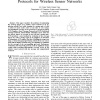Free Online Productivity Tools
i2Speak
i2Symbol
i2OCR
iTex2Img
iWeb2Print
iWeb2Shot
i2Type
iPdf2Split
iPdf2Merge
i2Bopomofo
i2Arabic
i2Style
i2Image
i2PDF
iLatex2Rtf
Sci2ools
PERCOM
2005
ACM
2005
ACM
Energy Efficient Differentiable Coverage Service Protocols for Wireless Sensor Networks
This paper considers the problem of maintaining the coverage degree of a wireless sensor network at an application specific level while keeping the sensing units of only a subset of sensor nodes active at any time to save energy. Two distributed coverage service protocols are proposed, namely NCP (Neighbor- Based Coverage Protocol) and GCP (Grid-Based Coverage Protocol), which identify redundant sensor nodes for the desired degree of coverage to turn off their sensing units. NCP introduces a novel method for evaluation of the coverage degree of a node's sensing region by its neighbors to determine its redundancy. GCP explores the idea of dividing the target area using a virtual hexagonal-grid during which all but one sensor node with the highest residual energy are identified as redundant for the coverage of the corresponding grid unit. Performance evaluations show that both protocols result in significant energy savings while providing differentiable coverage service in the wirel...
Grid-Based Coverage Protocol | PERCOM 2005 | Redundant Sensor Nodes | Wireless Networks | Wireless Sensor Network |
Related Content
| Added | 24 Dec 2009 |
| Updated | 24 Dec 2009 |
| Type | Conference |
| Year | 2005 |
| Where | PERCOM |
| Authors | Hasan Çam, Hidayet Ozgur Sanli |
Comments (0)

